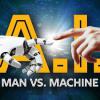
Breaking News
 The Days of Democracy Are Over
The Days of Democracy Are Over
 Elon Musk Described an AI Device to Replace Phones in 5 Years
Elon Musk Described an AI Device to Replace Phones in 5 Years
 Deposit Insurance For Billionaires?
Deposit Insurance For Billionaires?
 Rep. Troy Balderson Is Right: Coal And Gas Drive Affordable, Reliable, And Clean Energy
Rep. Troy Balderson Is Right: Coal And Gas Drive Affordable, Reliable, And Clean Energy
Top Tech News
 Graphene Dream Becomes a Reality as Miracle Material Enters Production for Better Chips, Batteries
Graphene Dream Becomes a Reality as Miracle Material Enters Production for Better Chips, Batteries
 Virtual Fencing May Allow Thousands More Cattle to Be Ranched on Land Rather Than in Barns
Virtual Fencing May Allow Thousands More Cattle to Be Ranched on Land Rather Than in Barns
 Prominent Personalities Sign Letter Seeking Ban On 'Development Of Superintelligence'
Prominent Personalities Sign Letter Seeking Ban On 'Development Of Superintelligence'
 Why 'Mirror Life' Is Causing Some Genetic Scientists To Freak Out
Why 'Mirror Life' Is Causing Some Genetic Scientists To Freak Out
 Retina e-paper promises screens 'visually indistinguishable from reality'
Retina e-paper promises screens 'visually indistinguishable from reality'
 Scientists baffled as interstellar visitor appears to reverse thrust before vanishing behind the sun
Scientists baffled as interstellar visitor appears to reverse thrust before vanishing behind the sun
 Future of Satellite of Direct to Cellphone
Future of Satellite of Direct to Cellphone
 Amazon goes nuclear with new modular reactor plant
Amazon goes nuclear with new modular reactor plant
 China Is Making 800-Mile EV Batteries. Here's Why America Can't Have Them
China Is Making 800-Mile EV Batteries. Here's Why America Can't Have Them
Muscle-powered mechanism desalinates up to 8 liters of seawater per hour

Currently the subject of a Kickstarter campaign, the QuenchSea 3.0 is made by British company Hydro Wind Energy. The firm debuted the original human-powered QuenchSea device back in 2020, followed by the smaller deep-sea-pressure-powered QuenchSea Reel in 2023.
On the original model, users arm-pumped a lever that forced seawater through a triple filtration system and a reverse osmosis membrane. The seawater was drawn in through one silicone tube that ran into the ocean, while the purified water was dispensed out of another tube that led to a bottle or other container.
This setup was said to remove salt, viruses, bacteria, microplastic particles and other contaminants from seawater at a claimed rate of over 2 liters (0.5 US gal) of water per hour on average, or up to 3 liters under ideal conditions. The resulting drinking water was claimed to meet World Health Organization (WHO) standards.
The 3.0 utilizes the same basic concept, but adds a pressure boosting mechanism and an energy recovery system. As a result, it's said to be easier to pump than the original and faster at desalination/filtration, reportedly putting out an impressive 6 to 8 liters (1.6 to 2 gal) of drinking water per hour.
QuenchSea promises that the purified water will contain less than 1,000 milligrams of total dissolved solids (TDS) per liter, a level that meets WHO standards. In fact, the device should typically bring seawater down to the neighborhood of 300 to 500 TDS, with the activated carbon in its filtration system removing off-putting tastes and odors.
It should be noted that both the reverse osmosis membrane and the filter cartridge will periodically need to be replaced. Depending on factors such as seawater salinity and temperature, one membrane should be good for about 300 liters (79 gal) of drinking water. We're still waiting to hear back about the cost of refills.
Assuming the QuenchSea 3.0 reaches production, a pledge of US$250 will get you one. Its planned retail price is $500.
The following video provides more information on how the device works.

 China Innovates: Transforming Sand into Paper
China Innovates: Transforming Sand into Paper

